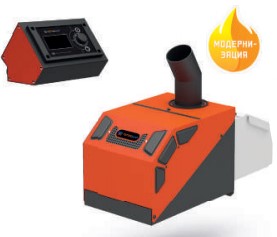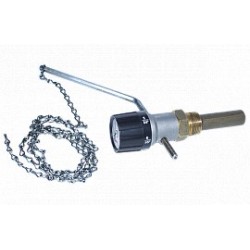Subcategories

Heating boiler Termol 22 with pellet burner 26 Comfort
- Reduced price
- Pack
How to choose a pellet boiler for a private home
A pellet boiler is a heating plant that uses pellets (pressed wood pellets) as fuel. The pellets are obtained from wood processing waste.
Boilers of this type have an efficiency of up to 90-93% and are often installed where gas supply is not available and electricity is expensive.
To properly heat your home, you need to consider some features that will help you buy a suitable pellet boiler.
Key points to look out for:
- Thermal calculation of premises
- Pellet burner
- Pellet feed mechanism (pellet auger)
- Heat exchanger
- Boiler versatility
- Automation
- Thermal calculation of premises.
When choosing a pellet boiler for a house or summer house, heat loss is calculated for each room and a heat calculation is performed.
The following main factors are taken into account for each room:
- Thermal insulation of walls;
- type of windows;
- Percentage of glazing;
- number of external walls;
- room type above the ceiling.
In general, it is necessary to calculate how much heat escapes through windows, doors and walls.
Simpler calculation - conditionally accepted with a ceiling height of up to 3 meters - 1 kW per 10 sq.m. heated room. For example, a house with an area of 150 sq.m. suitable pellet boiler with a capacity of about 15 kW. However, more often for better heating of the house in cold weather, buy a boiler with 30% more capacity than indicated in the calculation.
Pellet burner
The burner is most often made of cast iron or heat-resistant steel.
It is also worth paying attention to the burner type of the device:
The rotary burner can burn special wood pellets, fine coal, wood chips, sawdust, low cost, without capacity limitation. The negative features - size, complexity of installation, manual cleaning, as well as fuel ignition are easier to damage due to improper operation.
The torch burner is more versatile, it can work even with low quality fuel, it is more compact, the process is automated. On the downside, the cost is 20% higher than for a rotary torch.
Pellet feed mechanism (pellet auger)
The pellet boiler can have a rigid or flexible pellet screw.
Tight pellet auger
Rigid - simple, cheap and reliable, delivers pellets to the combustion zone without interruption. Disadvantages include the rigidity of the mount (the space is used less rationally) and the length limit (up to 2 meters).
Flexible pellet auger
The flexible pellet auger can reach 12 meters. This system makes efficient use of free space. The disadvantages - the complexity of the fastening.
Heat exchanger.
The heat exchanger differs in its position in the housing - vertically and horizontally. For a horizontal position, they accumulate less soot. With this layout, a chimney turbulence system can be created more efficiently. The vertical design promotes a sufficiently high temperature in the fuel combustion zone 1000 - 1100C, and the flue gases are also cooled to 100 - 150 degrees.
Depending on the production material, the heat exchanger can be cast iron or steel.
Cast iron heat exchanger is larger and heavier, harder to clean, but also lasts longer. Cast iron is a more fragile material, microcracks can form during transport.
The steel heat exchanger is lighter, more cost-effective, has fewer technological limitations, but is more prone to corrosion.
Boiler versatility.
Pellets only - some boilers can only operate with pellets
conditionally combined (pellets, coal, wood) - equipped with a special transforming furnace,
universal - they can burn any solid fuel, often there are several combustion chambers.
Automation.
The level of automation depends on the model, which provides ease of use.
Boiler models can be equipped with:
- automatic fuel supply;
- automatic ignition;
- sensors that allow to control the operation of the boiler;
- automatic cleaning;
- Possibility of remote boiler control, WI-FI module is installed for this purpose.
Indoor pellet boiler installation.
The boiler is installed in a dry room with a good ventilation system. The floor is better suited for tile or concrete. Care must be taken to supply the electricity needed to operate the boiler. The temperature at the installation site of the heating system must not be lower than 10 ºС.
Granules are easy to store, do not take up much space, it is better to store them in a dry place. 1 kg of pellets gives a heat output of about 5 kW per hour.
The pellet boiler is easy to operate: the pellets must be filled into the fuel tank. It can run for up to seven days on a single stack. An additional fuel tank can be fitted for longer operation. The location of the hopper must be taken into account, as small pellet boilers can be equipped with a built-in pellet hopper, as a result of which they take up less space, but still need to be filled with pellets more often.
The frequency of cleaning depends on the model: older once a week, younger 1-2 times a month.
Find out the prices of pellet boilers.
Need help choosing a pellet boiler? Ask a specialist questions! +37129751047

















